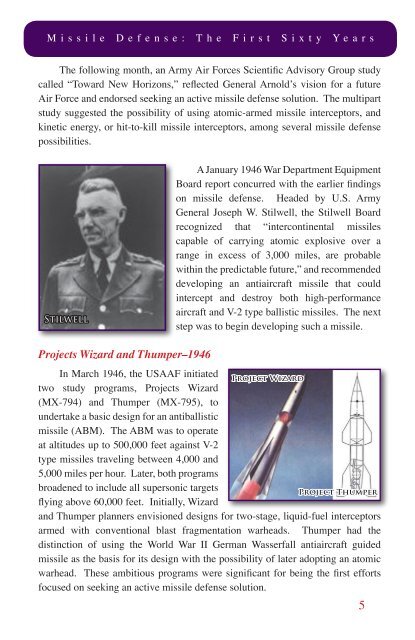Missile Defense: The First Sixty Years - The Missile Defense Agency
Missile Defense: The First Sixty Years - The Missile Defense Agency
Missile Defense: The First Sixty Years - The Missile Defense Agency
Create successful ePaper yourself
Turn your PDF publications into a flip-book with our unique Google optimized e-Paper software.
M i s s i l e D e f e n s e : T h e F i r s t S i x t y Y e a r s<br />
<strong>The</strong> following month, an Army Air Forces Scientific Advisory Group study<br />
called “Toward New Horizons,” reflected General Arnold’s vision for a future<br />
Air Force and endorsed seeking an active missile defense solution. <strong>The</strong> multipart<br />
study suggested the possibility of using atomic-armed missile interceptors, and<br />
kinetic energy, or hit-to-kill missile interceptors, among several missile defense<br />
possibilities.<br />
Stilwell<br />
Projects Wizard and Thumper–1946<br />
A January 1946 War Department Equipment<br />
Board report concurred with the earlier findings<br />
on missile defense. Headed by U.S. Army<br />
General Joseph W. Stilwell, the Stilwell Board<br />
recognized that “intercontinental missiles<br />
capable of carrying atomic explosive over a<br />
range in excess of 3,000 miles, are probable<br />
within the predictable future,” and recommended<br />
developing an antiaircraft missile that could<br />
intercept and destroy both high-performance<br />
aircraft and V-2 type ballistic missiles. <strong>The</strong> next<br />
step was to begin developing such a missile.<br />
In March 1946, the USAAF initiated Project Wizard<br />
two study programs, Projects Wizard<br />
(MX-794) and Thumper (MX-795), to<br />
undertake a basic design for an antiballistic<br />
missile (ABM). <strong>The</strong> ABM was to operate<br />
at altitudes up to 500,000 feet against V-2<br />
type missiles traveling between 4,000 and<br />
5,000 miles per hour. Later, both programs<br />
broadened to include all supersonic targets<br />
Project Thumper<br />
flying above 60,000 feet. Initially, Wizard<br />
and Thumper planners envisioned designs for two-stage, liquid-fuel interceptors<br />
armed with conventional blast fragmentation warheads. Thumper had the<br />
distinction of using the World War II German Wasserfall antiaircraft guided<br />
missile as the basis for its design with the possibility of later adopting an atomic<br />
warhead. <strong>The</strong>se ambitious programs were significant for being the first efforts<br />
focused on seeking an active missile defense solution.<br />
5

















